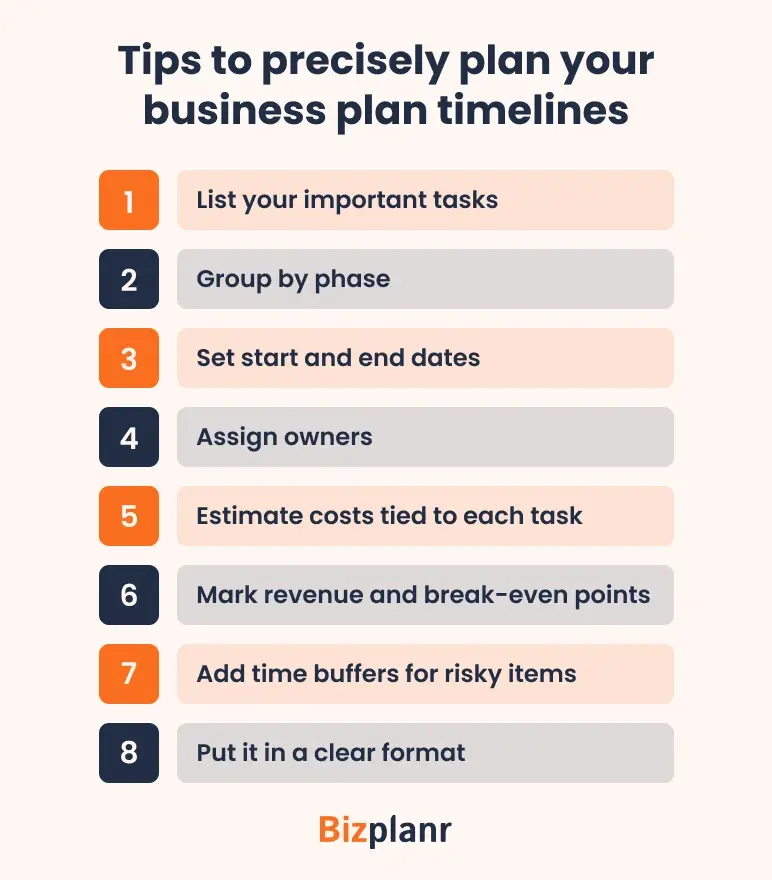You know when a business plan says “launch in Q3,” and everyone at the table nods like that actually means something?
It doesn’t. It usually means, “We haven’t decided yet, but Q3 sounds safe.”
People love putting milestones on a slide and drawing lines between them. These visuals look clean, but they rarely include the milestones where real work gets done.
Until someone asks, “So…who’s actually doing this?” Then it all falls apart.
This blog shows you how to develop a timeline in your business plan that tracks real progress, one that your team can follow, update, and actually use to hit key milestones on time.
What is a timeline in a business plan?
A business plan timeline is a roadmap that helps you focus on how and when your company will deliver the key milestones you’ve laid out. It ties your major milestones, important tasks and dates together so your team (and your investors) can see the plan in motion.
It brings together all the activities you’ve promised, like promotional rollouts, product releases, hiring goals, and sales targets, and shows how they’ll unfold over time.
Why should you mention timelines with milestones in your business plan?
If you’re setting milestones in your business plan but not assigning a timeframe to them, you’re not planning properly. A timeline fills that gap.
Gives clarity to your goals
You can say you’ll roll out the product, hit your sales targets, or expand into new markets, but without deadlines attached to those goals, they stay open-ended. A business plan timeline adds deadlines to each milestone.
Instead of “We’ll do this eventually,” it becomes “This happens in Month 4, and here’s who’s responsible.”
Forces structure, not just talk
Without timelines, your milestones are just ideas with no schedule. Once you add dates, they become part of an actual plan. You start building structures like breaking action items into steps, assigning them across platforms, and linking them to your budget, revenue, and team capacity.
A clear timeline also makes it easier to decide who’s doing what, when it’s due, and how the activities will be tracked along the way.
Tells everyone what’s next and when
When you attach timelines to milestones, your team knows exactly what needs to be done, who’s responsible for each deliverable, and when it’s due. No one is left waiting for instructions or assuming someone else is handling it.
It also makes it easier to review the movement of plans, see what’s running behind, and adjust the plan before small delays turn into missed releases.
Helps investors judge if your plan can work
Investors don’t need every milestone to land on the exact date you wrote down, but they do want to know that you’ve thought through the timing. A timeline shows you’ve mapped out how your strategy unfolds over time.
It gives them a way to understand when key results like launches, revenue targets, or break-even points are expected. That makes it easier for them to assess how realistic your plan is and whether you’re ready to follow through.
What to (generally) include in your timelines?
Before you open up a Gantt chart or start dragging colored bars across a slide, get clear on what actually belongs in your business plan timeline. A strong timeline covers more than just product deadlines. It shows how all major parts of the company move forward over time.
Here’s what that usually includes:
1) Product and operations timeline
This section maps out how you create and deliver your product or service and how business operations support that process. Include major development stages like finalizing design, starting user testing, and releasing version updates. For example:
- Finalize design by Q2 2025
- Begin testing in Q3
- Ship version 1.0 by Q4
You should also create a section for operational milestones like setting up manufacturing, onboarding vendors, or opening new locations. If you're planning internal systems, new workflows, or partnerships, those future changes should also be reflected here, along with what you aim to achieve operationally.
2) Marketing and customer timeline
This section helps you create a timeline that turns your marketing plan into real timing. Outline major campaign rollouts, like platform releases, referral programs, or PR events. Don’t just say “Start outreach in Q1.” Give specifics.
Add growth milestones, such as reaching user targets or retention benchmarks, so it’s clear what you aim to achieve at each stage. If you’re expanding into new regions or audiences, include those dates, too. For example:
- Q2 2025: Start an awareness campaign for a new region
- Q3 2025: Target X active users
- Year 2: Expand into a new segment
This helps stakeholders understand how momentum builds over time, what you’re working to achieve, and when future results should show up.
3) Financial and funding timeline
This part helps you create a connection between your financial plan and the timing of key actions. If you're raising capital, show when you expect each round to happen and what it will fund. Example:
- Q3 2025 – Raise seed round
- Q1 2026 – Secure funding for operational expansion
Also, mark when you expect to hit financial targets like break-even, revenue milestones, or net profit. You can include cost-saving initiatives, too, like reducing acquisition costs or improving margins by a set quarter.
This timeline gives your financial projections context. It should also highlight which milestones mark financial improvement or stability. You don’t need perfect predictions, just a timeline that shows how you create financial movement through real steps.
Tips to precisely plan your business plan timelines
Building a timeline for your business plan isn’t just about dropping activities into a table. It’s about thinking through what needs to happen, how long it will take, who’s in charge, and how it all ties back to your finances. Here’s how to plan it right.
1) List your important tasks
Start by listing everything your business needs to develop, such as product work, setup activities, funding steps, and internal services. This gives structure to your timeline in business plan documents.
2) Group by phase (pre/launch/post)
Group these into phases like early setup, rollout, and follow-up periods. Many businesses find it helpful to organize by timeframe or function to make the timeline easier to follow.
3) Set start and end dates
For each activity, define a clear start and end timeframe. Be realistic— timelines work better when your goals are specific, time-bound, and measurable. If you’re not sure how to frame them, use the SMART goals method.
4) Assign owners
Assign specific owners or partners to each item so responsibilities are clear. Don’t leave anything unclaimed.
5) Estimate costs tied to each task
Add rough cost estimates beside each activity to connect your timeline with financial needs. You can use templates that include budget columns for quick planning.
6) Mark revenue and break-even points
Highlight financial points like when you expect revenue to begin, when expenses stabilize, and when the business can sustain itself.
7) Add time buffers for risky items
Build in time buffers for any risky or uncertain items like external input, new development, or platform shifts.
8) Put it in a clear format (table or Gantt chart)
Use a clean timeline format. Gantt charts or structured tables work well as long as the layout makes your milestones and sequencing easy to understand. They help show how milestones connect across different parts of the business.
Conclusion
A clear timeline helps structure your business around what actually needs to get done and when. It connects milestones to real work, giving each point a purpose and sequence.
If you’re stuck on the format, Bizplanr helps by handling the layout with templates and Gantt tools that make your timeline easier to build and even easier to update.
The result is timelines you can actually use and a business that moves forward with intention.
Get Your Business Plan Ready In Minutes
Answer a few questions, and AI will generate a detailed business plan.
Frequently Asked Questions
How detailed should my business plan timeline be?
Include enough detail to show how each set of tasks connects to your business plan goals. Make sure the format shows when each point happens and what’s needed to develop or complete each milestone on the roadmap.
What’s the difference between a business timeline and a project plan?
A business timeline shows how different parts of the business move forward over time. A project plan goes deeper into task-level execution, often with more specific owners and dependencies.
Do I need different timelines for investors and internal use?
Yes. For investors, create a format that highlights high-level milestones and future outcomes. Internally, you’ll want more details tied to each point of work, costs, and project execution.
Can I use AI tools to generate or manage my timeline?
Yes, AI can help you create schedules, organize task phases, and format your timeline using tools like Gantt charts. It’s especially useful when you're short on time or building your business from scratch.






